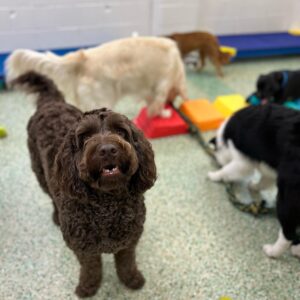Navigating the complex world of canine behaviour, especially aggression, requires an understanding that goes beyond traditional training methods. Recent research into conflict scaling, borrowing principles from fractal nature, chaos theory, and evolutionary game theory, offers a fresh perspective on understanding and managing canine aggression. By applying these concepts, we can develop a more nuanced approach to identifying and intervening in dog conflicts, from the subtlest signs to overt aggression.
 The Fractal Nature of Canine Conflict
The Fractal Nature of Canine Conflict
The idea that conflict follows a “power law distribution” implies that for every major display of aggression, there are numerous smaller, less visible conflicts. This pattern of escalation from minor tensions to outright aggression is not random but follows a predictable, albeit nonlinear, path. Recognising this can change how we perceive and address aggression in dogs.
Micro Conflict: The Unseen Precursor to Aggression
Deep beneath the surface of noticeable aggression lies micro conflict – subtle behaviours and interactions that often go unnoticed but are integral to the build-up of tension. These micro conflicts are akin to the early stages of human disagreements, which, if unresolved, can escalate to more serious confrontations.
Identifying and Addressing Micro Conflicts
Effective intervention starts with lowering our perception threshold to recognize these micro conflicts. A dog’s minor display of discomfort, subtle body language cues, or low-level resource guarding are all examples. By addressing these early signs, we can prevent the escalation into more serious aggressive behaviours.
The Role of Sequential Assessment and Evolutionarily Stable Strategies
Incorporating the hawk/dove game model from evolutionary game theory provides a framework to assess and predict a dog’s behaviour based on “resource holding potential.” Dogs, like other animals, engage in behaviours that they perceive as beneficial, weighing the costs and benefits of their actions. Understanding this can help in identifying the most effective intervention points.
The Complexity of Canine Social Pressure
Social pressure in dogs, ranging from jumping on guests to more assertive displays like barking at strangers, can be manifestations of micro conflict. These behaviours, if beneficial to the dog, may become part of their strategy to exert influence or control in their environment.
 The Importance of Not Overlooking Minor Conflicts
The Importance of Not Overlooking Minor Conflicts
In managing canine aggression, it’s crucial to not overlook minor conflicts. What appears as a significant behavioural issue might be underpinned by numerous smaller conflicts. Addressing these underlying issues can be key to resolving more visible problems.
Combining Theories for a Holistic Understanding
The intricate nature of canine aggression means that no single theory can comprehensively explain every aspect of it. The combination of conflict scaling laws and evolutionary game theory, along with other behavioural theories, provides a multifaceted understanding that acknowledges the complexity of canine behaviour.
The application of conflict scaling laws and game theory to canine aggression opens new avenues for understanding and intervening in dog behaviour. By paying attention to the nuances of micro conflicts and considering the broader context of a dog’s actions, we can develop more effective strategies for managing and preventing aggression. This holistic approach respects the complexity of canine behaviour and fosters a deeper, more empathetic relationship between dogs and their guardians.
In the intricate dance of canine behaviour, every step, no matter how small, plays a part in the overall dynamic. By understanding and respecting these subtleties, we can create a harmonious environment for our canine companions to thrive.